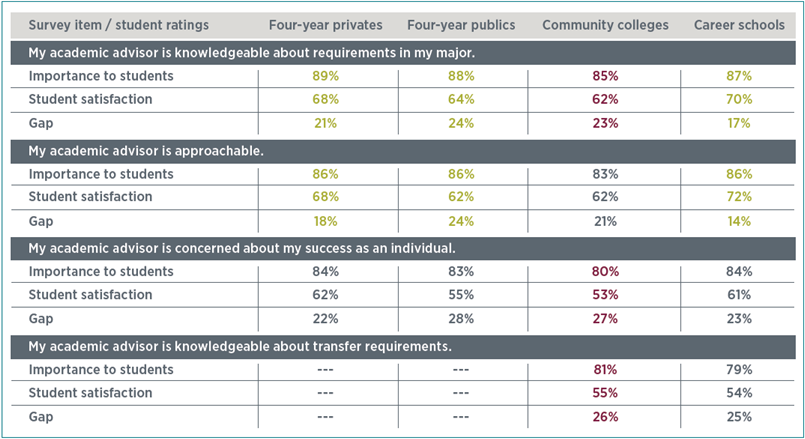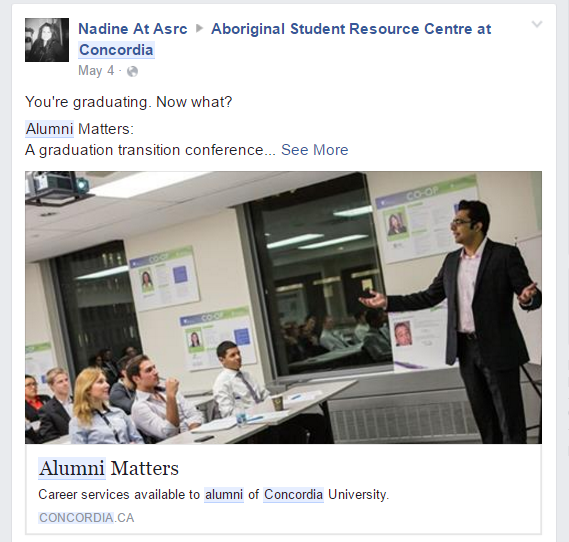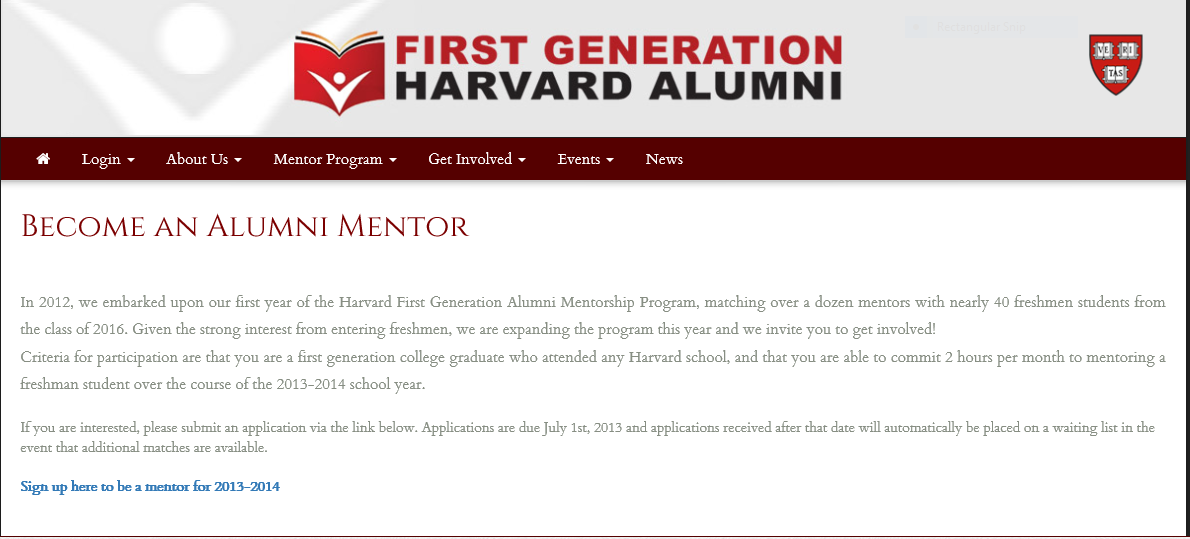
From an early age, we stress to students the importance of networking. We tell stories of jobs won and promotions secured on the golf course, at corporate cocktails, and of course through social media connections.
It seems everywhere you look, there’s a new blog post, ebook, or infographic on how to “network” your way to success. The underlying message? An excellent education isn’t quite enough; one also needs support from the right people to choose the right path, get noticed, and move forward.
High school seniors are told to seek out advice from academic advisers before settling on a degree program. Undergraduate and master students compete for internships to learn the ropes and make industry contacts. Career college students are encouraged toward programs with work placements where they’ll connect with professionals and build their CVs.
Practical guidance, shared expertise, real-world experience – all extolled as crucial complements to classroom learning.
It turns out, students have been listening.
More than ever, college and university students are evaluating the strength of your academic advising and mentoring programs during their decision-making process. They want access to knowledgeable “insiders.” They want to talk with grads who have successfully pursued similar career paths. Ultimately, they want visibility into how their academic training will help pave the way toward professional success. It’s all about ROI.

And once they’re enrolled? Improved career visibility through robust advising structures can make a dramatic impact on retention. Able to see how their degree or diploma translates into real world opportunities, students are less likely to transfer or drop out – and more likely to see their education through to completion.
And what about after graduation? It turns out that advising/mentorship programs that pair alumni with prospective and current students help those alumni feel more engaged with their alma mater. And even more likely to donate their time in the future.
Let’s look closer at the data behind some of these claims. And how schools are leveraging innovative advising and mentorship programs to attract, retain, and engage students, from pre- application through post-graduation.
What the Data Says About Mentorship, Tuition Rates, and Drop-outs
The fascinating 2015-16 National Student Satisfaction and Priorities Report (Ruffalo Noel Levitz) sheds light on the connection between 1) access to effective academic mentorship; 2) the perceived value of college tuition; and 3) students’ overall satisfaction with their educational experience.
Over 118, 000 online students in the US were surveyed from the report, from four-year private and public institutions, as well as community colleges and career schools. The purpose? To understand:
- which factors drive enrollment
- how satisfaction in key areas impacts re-enrollment
- how students rank their satisfaction (or lack thereof) in those key areas
If we zoom in on the section of the report that deals with academic advising, we find a particularly revealing chart that calculates the “gap” between students’ expectations of mentorship, and the services they actually receive at each type of institution. The data is somewhat damning – especially when you look at how important these early networking experiences are to students:
Academic Advising and Student Satisfaction

Students were also asked whether or not they felt their tuition was “money well spent.” In other words, did they feel confident that their investment in a diploma or degree would definitely pay off post-graduation? How important is this kind of security anyway?
This next chart reveals that it’s actually very important to students, and that schools across the board fall short in proving that increasingly high “sticker prices” are justified (particularly at four-year private institutions – community colleges fare somewhat better here).
Tuition and Student Satisfaction

Clearly, there’s a disconnect between the cost of education, its perceived value by students – and crucially, access to mentorship that helps ensure said education bears fruit. And this disconnect can directly impact drop-out rates.
In the United States, 70% of students study at four-year institutions, but less than 66% will graduate.
In fact, 30% of all undergrads drop out within their first year. And more than 75% of students required to take remedial courses will never graduate.
Furthermore, 60% of dropouts have no help from parents to pay tuition, and simply can’t balance jobs, school and family. There isn’t enough reassurance that sticking it out will be worth taking on huge amounts of debt, not to mention stress.
So how can schools help close their own ROI “satisfaction gaps”, and instill more confidence in their educational model?
Enter alumni mentorship and networking programs.
A school’s successful graduates are its strongest brand ambassadors. They are living proof that your educational model works, and that the trials, tribulations, and economic hardships of earning a degree will all pay off in the end.
Your grads understand exactly what it’s like to be your current or prospective students. In addition to strong internal college advising structures, alumni should play a key role in helping students build those crucial professional networks – and map a clear path forward to graduation and career success.
Your alumni success (job placement rates, acceptance to graduate programs, etc) should be at the heart of your student recruitment content strategy, your approach to retention, and plans for alumni nurturing.
Here’s a look at several institutions who have already embraced this approach, helping students make those first network connections that are so crucial to their academic and professional well being.
1. Muhlenberg College: A “New Network Paradigm”
Starting in the fall with a pilot program of 80 students, Muhlenberg College (a small liberal arts college in Pennsylvania) will introduce what president John Williams calls “a new network paradigm.”
This program will ensure that every single student gets a mentor.
The college has created a database of parents and alumni that students are required to connect with during their time at the school.

It’s the mandatory element that sets Muhlenberg’s new program apart from similar models. Plus the fact that each student must seek out and build rapport with a suitable mentor on their own, rather than being “matched up” by the institution.
President Williams wants to instill in students “a habit of establishing a network of advisors” and help them recognize the “value of value-added networks.”
This is something we’ve been telling students all along, but most post-secondary institutions fall short in actually teaching students how to network effectively.
At Muhlenberg, each student must learn how to approach participating alumni and parents, effectively present themselves, articulate their questions and goals, and ultimately engage the interest and support of a mentor.
Williams expects the new mentorship program will assist students with their first steps into the world of professional networking, and “help liberal arts students navigate that world.”
He goes on to say, “they will seek out mentors with similar career interests, but mentors will also be expected to help students figure out bigger, more personal questions: what they want to do, whom they aspire to be, what they want to achieve.”
Reports of the “new network paradigm” at Muhlenberg are already making news in education circles, as a progressive solution to closing the mentorship satisfaction gap so many post-secondary students experience – while helping validate the investment in a college education. This is crucial messaging for student recruitment campaigns, and an effective means of relationship-building with community parents and college alumni.
2. Concordia University: Grassroots to Grand-Scale Mentoring
Montreal-based Concordia University is way ahead of the game when it comes to offering students innovative networking opportunities with professionals in their field.
Concordia’s grassroots “Dinner for Eight” program ran successfully from February 2009 to 2013, and even won a silver medal for Best Alumni Program from the Canadian Council for the Advancement of Education.
Here’s a shot of one of the first alumni and student networking dinners, as covered in the Concordia Journal.

Twice a year, alumni volunteered to host four to seven students at a local restaurant, or in their homes, to share advice and answer questions.
It was an ideal way to help undergrads learn the nuances of professional networking in small group, social settings – much like those they would encounter as working professionals. Plus, the dinners gave alumni the opportunity to meet and potentially recruit rising talent.
I contacted Concordia to ask why they stopped running these networking dinners in 2013, and was told the institution felt compelled to scale up the mentorship and professional networking opportunities it offers students.
“Dinner for Eight” has been replaced with a three-day networking conference that includes workshops on everything from dressing for success and personal branding, to face time with professionals in a wide range of fields.


Here’s a look at Concordia promoting a recent mentorship “master class” held at the spring conference, led by alum and local investment analyst, Sain Godil (MSc in Finance).

The decision to expand the twice-yearly dinner program to a twice-yearly conference speaks to the growing demand for professional mentorship and networking opportunities from students across disciplines.
Smaller institutions (or programs) looking to generate more student inquiries, support re-enrollment, and engage alumni could definitely launch a program similar to “Dinner for Eight” – and scale it up as participation grows.
3. Barnard: Professional Mentorship with a Personal Touch
While Concordia University has transitioned its mentoring programs to the larger, more institutionalized conference format, Barnard College has intentionally maintained a more intimate, personalized approach.
In 2014, Sandra E. Will, Barnard’s “Alumnae-to-Student Mentoring Program” co-founder and advisory board member, launched a new piece of programming called February Social Month. Mentors led students through six different activities, including ice skating followed by hot chocolate at alumni homes, and a “what I wish I knew then” discussion over bagels – again, hosted by alumni at their homes.
The common theme is relationship-building through everyday activities – what Will calls a “holistic approach to mentoring” that includes not just career advice, but help sorting out which professional paths fit best with students’ personal goals and passions.
In a recent interview with Forbes, Wills summarizes her approach to alumni-student mentorship by asserting, “You can preach theory to people, but if you create a scenario of context and relevance and you’re willing to share the successes and failures that have happened in your life on a personal level, that’s very helpful.”
The data shows that Barnard’s mentorship program has also been great for alumni engagement. The program has an alumni retention rate of 40% and a new membership rate of 60%.
A combination of formal and informal alumni networking opportunities would probably be ideal for most educational institutions, and provide students (and volunteer mentors) with a variety of programming to choose from.
That being said, given the push toward personalization in online student recruitment, schools would be wise to tailor mentoring programming to the motivations and painpoints of their particular personas. And of course, promote these initiatives across all channels, including social media, website, email campaigns, and paid search landing pages.
4. University of Manchester: Speed Networking
The University of Manchester Pharmacy School (MPS) has managed to meld together the best of both worlds; personal face-to-face networking with alumni, hosted in a large, structured group setting.
MPS calls it “speed networking” and has launched the mentorship program with both current students, and local high school girls who are considering careers in STEM fields.
This snip from their promotional handbook describes exactly how the “Meet the Professionals” speed networking works:

MPS says this programming is all part of the university’s goal of improving student employability through access to, and relationship-building with established professionals in various fields. Feedback shows that these events have a tangible impact on students’ career planning.
In the high school-oriented version of the event, Dr. Linda Harris from Manchester University hosted a group of girls aged 13-15, all of whom had five minutes to question each member of staff about their education, career path and current role within the university.
According to Dr. Harris, the event did an excellent job of generating excitement around a career in academic research (at MPS or elsewhere), and building the girls’ confidence in pursuing STEM subjects at the post-secondary level.
It goes without saying that extending mentorship and networking opportunities to high schoolers is an excellent strategy for attracting your next generation of enrolled students!
The Statistical Relationship between Mentorship & Student Retention
Why have Stanford and Harvard recently established mentoring support programs for first generation (first-in-family) college students?
The answer is likely related to data that links effective mentorship, including professional networking, with vastly improved student retention rates.
As calls for diversity in student populations get louder, and schools aim to attract applicants from a broader range of backgrounds, the dropout rate of first gen’s becomes increasingly relevant (and problematic).
According to the Council of Independent Colleges (in collaboration with Georgetown University) about 1/3 of all undergraduates are first-generation college students.
The same data tells us that three out of five of those first gen students do not complete a degree within 6 years of study.
Other relevant facts from the study reveal that:
- Large shares of the American first generation college population are Hispanic and African-American
- 34% of first gen students are 30 years old or more
- Two-thirds attend for-profit or community colleges
- First gens are more likely to pursue part-time study
Schools with substantial numbers of first generation students, or that are looking to recruit from this demographic, would be wise to implement a range of mentorship programs. Evidence shows that first-in-family college students are particularly vulnerable to the stresses (both financial and psychological) of post-secondary school, and are more likely to drop out in the absence of effective support.
Students Rising Above (SRA) is a non-profit organization based in San Francisco that provides mentorship to first generation college students, with the goal of reducing drop out rates.

Through their work with high risk first-gen students across the country, SFA has proven that mentorship makes a profound impact on student retention. The college graduation success rate of their students is 90% – that’s more than three times greater than the national average for low-income, first-generation college students.
In a recent interview with Goodcall.com, executive director of Students Rising Above, Lynne Martin, said the secret lies in “teaching these students how to succeed in college, find support networks, gain access to internships, and learn both professional and soft skills that will help them once they graduate.”
SRA students work with a professional SRA Advisor and a volunteer adult mentor for five-plus years; from high school, through college, and into the workforce.
SRA provides an excellent model for colleges and universities who recognize advising and mentorship play a key part in student satisfaction, confidence, and re-enrollment.
It’s no coincidence that high-priced Ivy League institutions like Harvard and Stanford have recently initiated their own first-gen support and mentorship programs – a trend that was recently noted and written about in the New York Times.
Harvard intentionally matches first-gen alumni mentors with current first-gen students, to provide the kind of personalized support made possible by shared experience:

So there you have it. Some compelling reasons to consider implementing or beefing-up your own alumni-student mentoring programs. Still wondering if your school would truly benefit from such an approach? Here are a few quick questions to consider:
1. Are first-generation students an important segment of your school’s population?
2. Do your students tend to struggle with balancing school, work, and family commitments?
3. Do your students fail to re-enroll (or even get started) because they fear they can’t see their education through to the finish line?
4. Do your students express concern about paying for tuition and securing a job after graduation?
If you’ve answered “yes” to even one of these questions, a thoughtfully promoted alumni-student mentorship program could be the missing link in your student recruitment and retention strategy.
What’s your take on the rising demand for professional mentorship at the post-secondary level? Do you think alumni-student networking could help your school attract and retain more students? Let us know your thoughts or questions in the space below.





